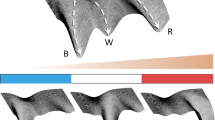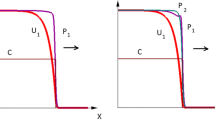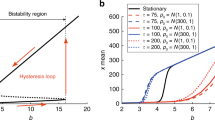Abstract
In this paper, we present a two-population continuous integro-differential model of cell differentiation, using a non-local term to describe the influence of the local environment on differentiation. We investigate three different versions of the model, with differentiation being cell autonomous, regulated via a community effect, or weakly dependent on the local cellular environment. We consider the spatial patterns that such different modes of differentiation produce, and investigate the formation of both stripes and spots by the model. We show that pattern formation only occurs when differentiation is regulated by a strong community effect. In this case, permanent spatial patterns only occur under a precise relationship between the parameters characterising cell dynamics, although transient patterns can persist for biologically relevant timescales when this condition is relaxed. In all cases, the long-lived patterns consist only of stripes, not spots.
Similar content being viewed by others
References
Armstrong, N. J., Painter, K. J., & Sherratt, J. A. (2006). A continuum approach to modelling cell-cell adhesion. J. Theor. Biol., 243, 98–113.
Armstrong, N. J., Painter, K. J., & Sherratt, J. A. (2009). Adding adhesion to a chemical signalling model for somite formation. Bull. Math. Biol., 71(1), 1–24.
Atkinson, S., & Williams, P. (2009). Quorum sensing and social networking in the microbial world. J. R. Soc. Interf., 6, 959–978.
Aubin-Houzelstein, G., Bernex, F., Elbaz, C., & Panthier, J. J. (1998). Survival of patchwork melanoblasts is dependent upon their number in the hair follicle at the end of embryogenesis. Dev. Biol., 198, 266–276.
Bloomfield, J. M., Sherratt, J. A., Painter, K. J., & Landini, G. (2010). Cellular automata and integrodifferential equation models for cell renewal in mosaic tissues. J. R. Soc. Interf. doi:10.1098/rsif.2010.0146.
Buckingham, M. (2003). How the community effect orchestrates muscle differentiation. Bioessays, 25, 13–16.
Caicedo-Carvajal, C. E., & Shinbrot, T. (2008). In silico zebrafish pattern formation. Dev. Biol., 315(2), 397–403.
Cossu, G., Kelly, R., Di Donna, S., Vivarelli, E., & Buckingham, M. (1995). Myoblast differentiation during mammalian somitogenesis is dependent upon a community effect. Proc. Natl. Acad. Sci. USA, 92(6), 2254–2258.
Galli, R., Borello, U., Gritti, A., Minasi, M. G., Bjornson, C., Coletta, M., Mora, M., De Angelis, M. G., Fiocco, R., Cossu, G., & Vescovi, A. L. (2000). Skeletal myogenic potential of human and mouse neural stem cells. Nature Neurosci., 3, 986–991.
Gerisch, A. (2010). On the approximation and efficient evaluation of integral terms in PDE models of cell adhesion. IMA J. Numer. Anal., 30, 173–194.
Gerisch, A., & Chaplain, M. (2008). Mathematical modelling of cancer cell invasion of tissue, Local and non-local models and the effect of adhesion. J. Theor. Biol., 250(4), 684–704.
Green, J. E. F., Waters, S. L., Whiteley, J. P., Edelstein-Keshet, L., Shakesheff, K. M., & Byrne, H. M. (2010). Non-local models for the formation of hepatocyte-stellate cell aggregates. J. Theor. Biol. DOI:10.1016/j.jtbi.2010.08.013.
Gurdon, J. B. (1988). A community effect in animal development. Nature, 336, 772–774.
Gurdon, J. B., Lemaire, P., & Kato, K. (1993a). Community effects and related phenomena in development. Cell, 75, 831–834.
Gurdon, J. B., Tiller, E., Roberts, J., & Kato, K. (1993b). A community effect in muscle development. Curr. Biol., 3, 1–11.
Hillen, T., & Painter, K. J. (2009). A user’s guide to PDE models for chemotaxis. J. Math. Biol., 58, 183–217.
Hultman, K. A., & Johnson, S. L. (2010). Differential contribution of direct-developing and stem cell-derived melanocytes to the zebrafish larval pigment pattern. Dev. Biol., 337(2), 425–431.
Kaneko, T., Kojima, K., & Yasuda, K. (2007). Dependence of the community effect of cultured cardiomyocytes on the cell network pattern. Biochem. Biophys. Res. Commun., 356(2), 494–498.
Kato, K., & Gurdon, J. B. (1993). Single-cell transplantation determines the time when Xenopus muscle precursor cells acquire a capacity for autonomous differentiation. Proc. Natl. Acad. Sci. USA, 90, 1310–1314.
Kim, D., Chi, S., Lee, K. H., Rhee, S., Kwon, Y. K., Chung, C. H., Kwon, H., & Kang, M. S. (1999). Neuregulin stimulates myogenic differentiation in an autocrine manner. J. Biol. Chem., 274, 15395–15400.
Kojima, K., Kaneko, T., & Yasuda, K. (2006). Role of the community effect of cardiomyocyte in the entrainment and reestablishment of stable beating rhythms. Biochem. Biophys. Res. Commun., 351(1), 209–215.
Kondo, S., Iwashita, M., & Yamaguchi, M. (2009). How animals get their skin patterns, fish pigment pattern as a live Turing wave. Int. J. Dev. Biol., 53, 851–856.
Maderspacher, F., & Nusslein-Volhard, C. (2003). Formation of the adult pigment pattern in zebrafish requires leopard and obelix dependent cell interactions. Development, 130(15), 3447–3457.
Monk, N. (1997). The community effect and ectoderm–mesoderm interaction in Xenopus muscle differentiation. Bull. Math. Biol., 59(3), 409–425.
Moreira, J., & Deutsch, A. (2005). Pigment pattern formation in zebrafish during late larval stages, A model based on local interactions. Dev. Dyn., 232(1), 33–42.
Nagai, T., Otani, S., Saito, T., Maegawa, S., Inoue, K., Arai, K., & Yamaha, E. (2005). Germ-line chimera produced by blastoderm transplantation in zebrafish. Nippon Suisan Gakkaishi, 71(1), 1–9.
Nieuwkoop, P. D. (1997). Short historical survey of pattern formation in the endo-mesoderm and the neural anlage in the vertebrates, the role of vertical and planar inductive actions. Cell. Mol. Life Sci., 53, 305–318.
Painter, K. J., Armstrong, N. J., & Sherratt, J. A. (2010). The impact of adhesion on cellular invasion processes in cancer and development. J. Theor. Biol., 264, 1057–1067.
Paratore, C., Hagedorn, L., Floris, J., Hari, L., Kleber, M., Suter, U., & Sommer, L. (2002). Cell-intrinsic and cell-extrinsic cues regulating lineage decisions in multipotent neural crest-derived progenitor cells. Int. J. Dev. Biol., 46(1), 193–200. Sp. Iss. SI.
Parichy, D. M. (2007). Homology and the evolution of novelty during Danio adult pigment pattern development. J. Exp. Zool. B, 308(5), 578–590.
Parichy, D. M., Ransom, D. G., Paw, B., Zon, L. I., & Johnson, S. L. (2000). An orthologue of the kit-related gene fms is required for development of neural crest-derived xanthophores and a subpopulation of adult melanocytes in the zebrafish, Danio rerio. Development, 127, 3031–3044.
Rawls, J., & Johnson, S. (2000). Zebrafish kit mutation reveals primary and secondary regulation of melanocyte development during fin stripe regeneration. Development, 127(17), 3715–3724.
Salazar-Ciudad, I., Jernvall, J., & Newman, S. A. (2003). Mechanisms of pattern formation in development and evolution. Development, 130, 2027–2037.
Sekimura, T., Zhu, M., Cook, J., Maini, P. K., & Murray, J. D. (1999). Pattern formation of scale cells in Lepidoptera by differential origin-dependent cell adhesion. Bull. Math. Biol., 61, 807–828.
Sherratt, J. A., Gourley, S. A., Armstrong, N. J., & Painter, K. J. (2009). Boundedness of solutions of a non-local reaction-diffusion model for adhesion in cell aggregation and cancer invasion. Eur. J. Appl. Math., 20(1), 123–144.
Standley, H. J., Zorn, A. M., & Gurdon, J. B. (2001). eFGF and its mode of action in the community effect during xenopus myogenesis. Development, 128(8), 1347–1357.
Watt, F. M., Lo Celso, C., & Silva-Vargas, V. (2006). Epidermal stem cells, an update. Curr. Opin. Genet. Dev., 16, 518–524.
Weiner, R., Schmitt, B. A., & Podhaisky, H. (1997). ROWMAP—A ROW-code with Krylov techniques for large stiff ODEs. Appl. Numer. Math., 25(2), 303–319.
Weston, M. J. D., Kato, K., & Gurdon, J. B. (1994). A community effect is required for amphibian notochord differentiation. Dev. Genes Evol., 203(5), 250–253.
Yamaguchi, M., Yoshimoto, E., & Kondo, S. (2007). Pattern regulation in the stripe of zebrafish suggests an underlying dynamic and autonomous mechanism. Proc. Natl. Acad. Sci. USA, 104(12), 4790–4793.
Yang, H., Jensen, P., & Goldowitz, D. (2002). The community effect and purkinje cell migration in the cerebellar cortex, analysis of scrambler chimeric mice. J. Neurosci., 22(2), 464–470.
Zhong, W. (2008). Timing cell-fate determination during asymmetric cell divisions. Curr. Opin. Neurobiol., 18, 472–478.
Author information
Authors and Affiliations
Corresponding author
Rights and permissions
About this article
Cite this article
Bloomfield, J.M., Painter, K.J. & Sherratt, J.A. How Does Cellular Contact Affect Differentiation Mediated Pattern Formation?. Bull Math Biol 73, 1529–1558 (2011). https://doi.org/10.1007/s11538-010-9578-4
Received:
Accepted:
Published:
Issue Date:
DOI: https://doi.org/10.1007/s11538-010-9578-4




